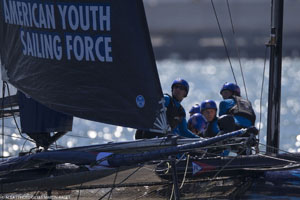Most of the 10 teams competing in the first Red Bull Youth Americas Cup Sept. 1-4 didn't have to worry about money.
The teams from Europe, Australia, and New Zealand had corporate sponsors. Others had members that came from wealthy families with resources at the ready.
Not the American Youth Sailing Force, which had three members who are either current or former UC Santa Cruz students. This scrappy group of nine 19- to 24-year-olds needed to raise about $250,000 themselves in order to compete. So, the young sailors held auctions, networked, and learned how to make fundraising speeches. They slept on the floor of an office building while they trained, and lived off eggs and PBJ sandwiches.
Not only did team American Youth Sailing Force win the inaugural race of the four-day series but, by the third day, it was tied for first position. One bad race and high winds that cancelled the final event left the team with a fifth-place finish — just three points out of second.
"It was the most amazing sailing campaign I've ever been involved in," said 22-year-old Cooper Dressler (Oakes '13, Earth sciences) of the Americas-Cup-like event. "It was kind of a bucket-list thing that I didn't even realize I wanted, until I did it."
Dressler and his UCSC teammates — 21-year-old Mikey Radziejowski (Merrill '14, history) and 22-year-old Tommy Pastalka, who graduated from UCSC with a degree in environmental studies — had lots of experience racing high-performance skiffs. But the Youth Americas Cup's AC45s were like something out of a James Bond movie. The high-tech catamarans carried a 72-foot wing sail — basically an upright airplane wing that can push the boat to speeds of 35 mph — and had a carbon fiber body that made them light and maneuverable.
"It's kind of like sitting on top of a car that's flying down a parkway," Dressler said of sailing the speedy vessels. "But the whole time the car is moving, you have to get up and do these jobs."
Because the AC45s require such precision and physical stamina to sail, Team American Youth Sailing Force spent four months of 12-hour days preparing for the race. Each day, they sailed the San Francisco Bay, held strategy sessions, and worked out at a nearby gym — sometimes fitting in two sessions of weight-lifting and cardiovascular conditioning.
"When you sail an AC45, especially when you race, it's kind of like doing a full sprint the whole time — except it's with your upper body," Dressler said. "You are constantly close to your maximum heart rate of 190 beats per minute. You're on the brink of exhaustion the whole time, but you have to make tactical decisions too."
According to Dressler and Radziejowski, the races were adrenalin-filled battles of timing and tactics. Seawater dashed over the hulls and the boat's underwater foils hummed almost to a scream as the crew worked the winches and adjusted the sails while trying to outmaneuver the competition.
Once, a member of the American Youth Sailing Force team fell off the boat mid-race, forcing the crew to instantly have to redistribute all its tasks. Another time, the boat snagged a race buoy, causing the craft to nearly stand up on its bow before the sailors brought it back under control.
"It was a huge group effort," said Radziejowski, who hopes to become a professional sailor some day. "All nine of us really got along well. We had fun and pushed each other. Everyone worked really hard and no one slacked. That was the biggest success of our team."



